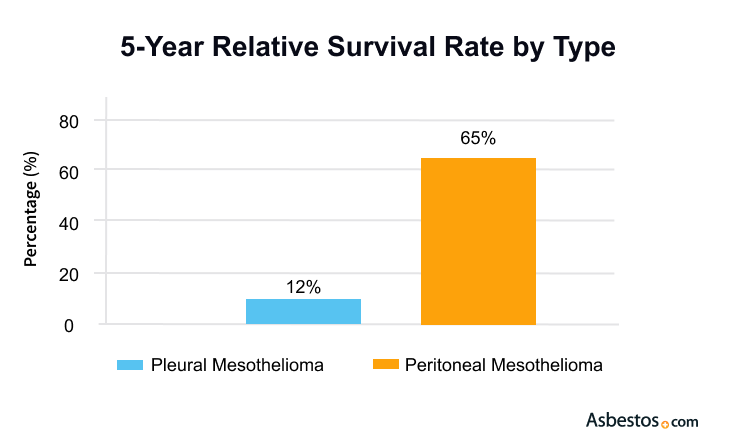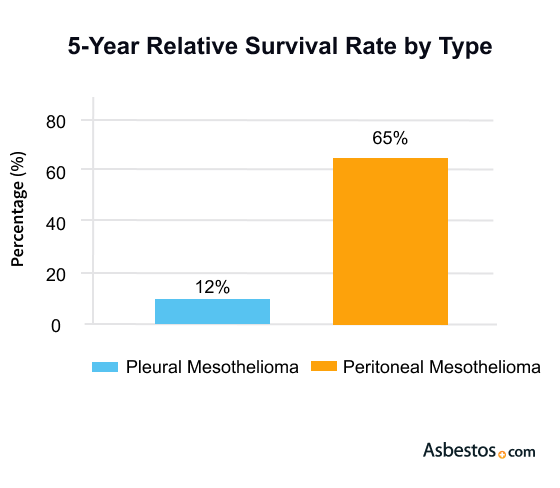Get Your Free Mesothelioma Guide

Find a Top Mesothelioma Doctor

Access Help Paying for Treatment

Mesothelioma survival rates depend on treatment and cancer stage. The average survival rate for mesothelioma is about 15 months after diagnosis with treatment. The five-year survival rate for pleural mesothelioma is approximately 12%. Some patients have lived for more than 10 years after treatment.
Mesothelioma survival rates are the percentage of cancer patients alive 1 year or more after diagnosis. The latest 5-year survival rate for pleural mesothelioma is 12%, based on the most recent data from the Surveillance, Epidemiology, and End Results database. In other words, patients with pleural mesothelioma are about 12% more likely than those who don’t have pleural mesothelioma to live at least 5 years after their diagnosis. For peritoneal mesothelioma, SEER shows it’s much higher at 65%.
Statistics may not apply to any one individual. Some mesothelioma patients may live for a long time after treatment. For example, peritoneal mesothelioma survivor Tammy Frank has been alive 25 years beyond her life expectancy.
Survival rates for mesothelioma depend on a few factors. They include the cancer’s location and stage. They also depend on the patient’s health and treatments. The top ways to treat mesothelioma are surgery, chemo, radiation and immunotherapy.
The National Cancer Institute issues data on mesothelioma survival every few years. It does so through the SEER program. The data shows a steady trend of improved survival rates over the past 2 decades.
Your doctor will use mesothelioma survival rate data to assess your prognosis. This data is based on thousands of cases. It averages patient survival times. It can’t predict your outcome. But, it can show you what happened to similar patients.
“What frustrates me most, and I hear this often with new patients, is, ‘I just saw my doctor today, and they said I have a year to 16 months to live.’ That is not the case,” says RN and Patient Advocate Karen Selby. “You’re an individual. This is your story.”
Survival rate data is one piece of the puzzle. A doctor uses it to find the best mesothelioma treatment for you. For example, stats show younger patients survive at higher rates. They can qualify for aggressive treatments. If you’re a younger patient, your doctor may recommend surgery, for example.
There have been people who survived way beyond what the statistics say. I plan on being one of those. I have a lot of people counting on me being around. I’m not going to disappoint them.
Survival rates for mesothelioma vary depending on factors such as the cancer’s stage, location and treatment type. Age, gender and overall health also matter. These affect how long a person will live after a mesothelioma diagnosis.
Women and younger patients tend to live longer. Those with peritoneal tumors, early-stage disease or epithelioid cells often live a longer life. So do those who pursue multimodal therapy.
Peritoneal mesothelioma has a much better survival rate than pleural disease. About 65% of all peritoneal mesothelioma patients survive for 5 years or more.
This is 5 times the 5-year survival rate compared to pleural patients. Eligible patients with asbestos-related cancer in the peritoneum live between 31 months and 103 months with HIPEC surgery.
Women diagnosed with mesothelioma tend to have longer survival rates compared to men. This trend holds true regardless of age, mesothelioma stage, race or treatment type. For instance, the 5-year relative survival rate for pleural mesothelioma is 21.42% for women, compared to 9.3% for men.
Researchers are exploring why women with mesothelioma live longer than men. Women are also more likely to be diagnosed with peritoneal mesothelioma. This type of mesothelioma has better survival than pleural tumors. This skews survival rates to favor women, who live longer on average.
Get Your Free Mesothelioma Guide

Find a Top Mesothelioma Doctor

Access Help Paying for Treatment

Younger people with mesothelioma have better survival outcomes compared to older patients. Approximately 75% of mesothelioma patients diagnosed before age 50 survive at least one year after diagnosis. But only 44% of patients aged 65 or older with mesothelioma live for one year. Age is a significant factor in mesothelioma survival rates, as younger individuals often respond better to treatment.
Younger patients are usually healthier. So, they can use more aggressive and effective therapies. They’re also less likely to have other, lasting health issues at the same time. Older patients are more likely to have other lung diseases, diabetes or a history of cancers.
Pleural mesothelioma survivor Kevin Sinyard far surpassed the average mesothelioma survival rate. He was initially told he only had 6 months to live before undergoing extrapleural pneumonectomy surgery. He then underwent aggressive chemotherapy and radiation regimens. Kevin told us, “I’m proof that you can survive and still live a really good life.”
The stage of mesothelioma at diagnosis is a strong predictor of your overall survival. The SEER Program groups cancer survival rates into: Localized, regional and distant stages. This grouping distills the 4 pleural mesothelioma stages into 3. “Localized” represents stage 1. “Regional” roughly represents stages 2 and 3. “Distant” represents stage 4.
Patients in the early stages have better survival rates if treated quickly. They’re more likely to qualify for surgery and other aggressive treatments. More aggressive therapies are linked to better outcomes.
| 1-Year | 3-Year | 5-Year | |
|---|---|---|---|
| Stage 1-2 | 61.1% | 30.7% | 20.6% |
| Stage 3 | 56.7% | 26.0% | 13.8% |
| Stage 4 | 42.9% | 15.7% | 9.2% |
The types of cells that make up tumors impact patient survival. Mesothelioma has 3 cell types: Epithelioid, sarcomatoid and biphasic.
Biphasic tumors have epithelioid and sarcomatoid features. A higher count of epithelial cells means a better prognosis for mesothelioma patients. If a patient’s cancer is mostly sarcomatoid cells, their mesothelioma life expectancy is lower.
Mesothelioma patients with a history of smoking, heavy alcohol use or poor diet tend to have lower survival rates. Coexisting conditions, such as heart disease and diabetes, can affect your survival as well.
Good nutrition and exercise can help you live longer. A healthy diet and regular exercise help patients respond better to cancer treatment.
Your genes and family history also play a role. More than 90% of mesothelioma cases occur in white men. But Black patients have a nearly 5% better 5-year survival rate.

Learn how the FDA-approved Keytruda and chemotherapy combo brings new hope for mesothelioma in this free webinar recording.
Get a RecordingMesothelioma survival rates depend on the type and stage of the cancer. Pleural mesothelioma is the most common type. It’s more aggressive and harder to detect early. Most patients live 12 to 21 months after diagnosis.
Peritoneal mesothelioma affects the abdomen. It responds better to treatment. For example, surgery and heated chemo or HIPEC greatly boosts survival in patients.
Pericardial mesothelioma is a rare cancer around the heart. It’s usually diagnosed late. The average life expectancy is 3 to 10 months. Treatment is mainly for symptom relief. Testicular mesothelioma is the rarest type, affecting the area around the testes. Patients often live 20 months to 2 years, depending on the stage and treatment.
| Type of Mesothelioma | Average Life Expectancy | 5-Year Survival Rate |
|---|---|---|
| Pleural Mesothelioma | 12-21 months | 12% |
| Peritoneal Mesothelioma | 3-5 years (with HIPEC) | 65% |
| Pericardial Mesothelioma | 3-10 months | Less than 1% |
| Testicular Mesothelioma | 20 months-2 years | Data is limited |
Comparing 5-Year Survival Rates
The 5-year survival rate is 12% for pleural mesothelioma. For peritoneal mesothelioma, it’s 65%.
Many peritoneal patients live more than 5 years if treated early. We also work with pleural patients who have lived more than 5 years from the time of their diagnosis. Michael Cole, for example, is a 9-year pleural mesothelioma survivor.


Many factors can improve the survival rate for mesothelioma patients. An early diagnosis and access to new treatments, such as immunotherapy and targeted therapies, play a critical role in extending survival. Long-term survivors say that coordinated care and clinical trials helped them. Some survivors also emphasize the importance of lifestyle changes. For example, a healthier diet helped them after diagnosis.
Don’t assume your prognosis is based only on mesothelioma survival stats. A 5-year survival rate doesn’t show how mesothelioma cancer symptoms may affect your quality of life. Each patient reacts differently to treatment. Chemo, surgery and immunotherapy can help people live longer.
A study of pleural patients found that, on average, those who got surgery, chemo and radiation lived for 21.7 months. Those who declined treatment survived for 10.2 months.
Another study in the Journal of Cancer Research and Clinical Oncology found patients with better nutrition lived 18 months, on average. Those with poor nutrition lived for 11 months.
Your overall health and treatment for mesothelioma may help you live longer than the survival rates suggest. The 5-year survival rates don’t consider the most recent advances in medicine.
Statistics may be a source of comfort for some people and confusing or frightening for others. However, survival rates only consider people diagnosed in the past. Those diagnosed today may have more therapy choices and a better chance of survival. New treatments are helping people live longer.
“We had been living a ‘live the year’ type of thing. But after recovery, now it’s not only that we have a bucket list. We have a ‘we’re going to do this’ list,” Brunilda Villareal, the wife of a mesothelioma survivor, told us. “Tomorrow is very important. It’s sacred.”
“New therapies, like immunotherapy and vaccines, are changing how we treat cancer. “Hopefully, these trends will lead to longer survival and a cure.”
Based on tumor location alone, survival rates vary. The average 5-year survival rate for pleural mesothelioma is about 12%. For peritoneal mesothelioma, it’s 65%. Cell type, mesothelioma stage, age, sex and overall health also influence the survival rate.
Malignant mesothelioma is an aggressive and fatal disease, however, some patients have survived more than 10 years after their diagnosis. While there is no cure for this cancer, there have been advances in care. Most mesothelioma patients only survive approximately 12 months after diagnosis, but treatment may extend mesothelioma survival.
Survival rate is the percent of cancer patients who live a certain number of years after diagnosis. For example, 20.7% of mesothelioma patients live for 3 years or more. The mesothelioma mortality rate is the number of deaths in certain areas and groups of people. For example, in 2021, there were 0.7 mesothelioma deaths per 100,000 people in the U.S.
The 5-year survival rate for mesothelioma patients is about 12%. The 5-year survival rate for lung cancer patients is about 26.6%.
People with health conditions are at risk of treatment complications. Heart disease, diabetes and high blood pressure can be risk factors. Some patients may not qualify for surgery if they have these conditions. Surgery is the most effective therapy to extend survival.
Your web browser is no longer supported by Microsoft. Update your browser for more security, speed and compatibility.
If you are looking for mesothelioma support, please contact our Patient Advocates at (855) 404-4592
The Mesothelioma Center at Asbestos.com has provided patients and their loved ones the most updated and reliable information on mesothelioma and asbestos exposure since 2006.
Our team of Patient Advocates includes a medical doctor, a registered nurse, health services administrators, veterans, VA-accredited Claims Agents, an oncology patient navigator and hospice care expert. Their combined expertise means we help any mesothelioma patient or loved one through every step of their cancer journey.
More than 30 contributors, including mesothelioma doctors, survivors, health care professionals and other experts, have peer-reviewed our website and written unique research-driven articles to ensure you get the highest-quality medical and health information.
My family has only the highest compliment for the assistance and support that we received from The Mesothelioma Center. This is a staff of compassionate and knowledgeable individuals who respect what your family is experiencing and who go the extra mile to make an unfortunate diagnosis less stressful. Information and assistance were provided by The Mesothelioma Center at no cost to our family.LashawnMesothelioma patient’s daughter


Selby, K. (2025, April 8). Mesothelioma Survival Rate. Asbestos.com. Retrieved April 14, 2025, from https://www.asbestos.com/mesothelioma/survival-rate/
Selby, Karen. "Mesothelioma Survival Rate." Asbestos.com, 8 Apr 2025, https://www.asbestos.com/mesothelioma/survival-rate/.
Selby, Karen. "Mesothelioma Survival Rate." Asbestos.com. Last modified April 8, 2025. https://www.asbestos.com/mesothelioma/survival-rate/.
Dr. Rupesh Kotecha is a renowned radiation oncologist in leadership roles at Miami Cancer Institute. He is an associate professor at Florida International University's college of medicine and an adjunct faculty member at Memorial Sloan Kettering.
Our fact-checking process begins with a thorough review of all sources to ensure they are high quality. Then we cross-check the facts with original medical or scientific reports published by those sources, or we validate the facts with reputable news organizations, medical and scientific experts and other health experts. Each page includes all sources for full transparency.
Please read our editorial guidelines to learn more about our content creation and review process.
